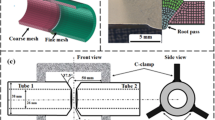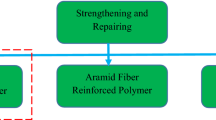Abstract
This paper is concerned with the behaviour of duplex stainless steel reinforcing bar following exposure to elevated temperatures from a fire followed by subsequent cooling. The study focuses on duplex grade 1.4362 reinforcing bar, and includes both hot-rolled and cold-rolled variants. Grade 1.4362 duplex stainless steel reinforcement has become a popular choice for reinforced concrete owing to its excellent combination of outstanding mechanical behaviour and corrosion resistance as well as cost-effectiveness. There is no information on the post-fire performance of duplex 1.4362 reinforcing bar available, despite being necessary for an engineer that may wish to study the structural integrity of a relevant structure following a fire. To address this gap in the existing knowledge, this paper presents a detailed discussion and analysis based on a series of laboratory experiments comprising mechanical and metallurgical testing. It is shown that grade 1.4362 duplex stainless steel reinforcing bars perform unlike any other types of carbon steel or austenitic stainless steel rebars, owing to the austenite-ferrite grain boundary, and the associated instabilities. Based on the results presented in this paper, a series of recommendations are proposed for the post-fire mechanical property retention factors that can be used in assessment and design. Finally, this paper aims to highlight the potential for rehabilitation and salvage of existing reinforced concrete structures following a fire, and aid in the prevention of unnecessary demolition and replacement.



Adapted from [8]








Similar content being viewed by others
Abbreviations
- f u :
-
Ultimate tensile stress
- f 0.2p :
-
0.2% Proof stress
- ε f :
-
Total strain at failure
- ε u :
-
Percentage total elongation at maximum force
- E :
-
Modulus of elasticity
References
Steel-Sci (2021) Properties of Stainless Steel Rebar. https://www.stainlesssteelrebar.org/stainless-properties/.Accessed 18 May 2021
Government of Canada (2021) Pont Samuel-De Champlain—Foire aux questions. https://www.infrastructure.gc.ca/nbsl-npsl/faq-fra.html#q1. Accessed 18 May 2021
worldstainless.org (2019) Samuel De Champlain Bridge—ISSF Stainless Steel in Bridges, worldstainless.org
worldstainless.org (2016) River Delta Crossing—ISSF Stainless Steel in Infrastrucutre, worldstainless.org
Mondal R, Rajapgopal A, Bonagani S, Prakash A, Fuloria D, Sivaprasad P, Chai G, Kain V, Samajdar I (2020) Solution annealing of super duplex stainless steel: correlating corrosion performance with grain size and phase-specific chemistry. Metall Mater Trans 51:2480–2494
Cardoso JL, Pacheco MS, Araujo A, Riberio J (2018) Stainless steel rebar for marine environment: study of galvanic corrosion with carbon steel rebars used in the same concrete structure
Bertolini L, Gastaldi M (2011) Corrosion resistance of low-nickel duplex stainless steel rebars. Mater Corros 62(2):120–129
Gardner L, Bu Y, Francis P, Baddoo NR, Cashell KA, McCann F (2016) Elevated tempreture material properties of stainless steel reinforcing bar. Constr Build Mater 114:977–997
Rehman F, Cashell KA, Anguliano L (2022) Experimental study of the post-fire mechanical and material response of cold-worked austenitic stainless steel reinforcing bar. Materials 15:1564
Felicetti R, Gambarova PG, Meda A (2009) Residual behavior of steel rebars and R/C sections after a fire. Constr Build Mater 23:3546–3555
Tao Z, Wang X-Q, Hassan MK, Song T-Y, Xie L-A (2018) Behavior of three types of stainless steel after exposure to elevated temperatures. J Constr Steel Res 152:296–311
Pramanik BA, Kumar A (2015) Stainless steel: microstructure, mechanical properties and methods of application, Nova
Beddos J, Parr JG (1999) Introduction to Stainless Steel, 3rd edn. ASM International, Washington
International Stainless Steel Forum (2020) The Stainless Steel Family. ISSF
BS EN 10088-1 (2014) Stainless Steel Part 1: List of stainless steels. British Standards Institute
Rodrigues DG, Maria GGB, Viana BAL, Santos DB (2019) Effect of low cold-rolling strain on microstructure, texture, phase transformation, and mechanical properties of 2304 lean duplex stainless steel. Mater Charact 150:138–149
Danieli Group (2021) SN Longos reconfirms its confidence in Danieli Rebar-in-Coil Technology, Accessed 25 Nov 2015. https://www.danieli.com/en/news/news-events/sn-longos-reconfirms-its-confidence-danieli-rebar-coil-technology_37_18.htm. Accessed 2021
BS 6744:2016 (2016) Stainless Steel Bars—Reinforcement of concrete—requirements and test methods. British Standard Institute
Twilt L (1988) Strength and deformation properties of steel at elevated temperatures. Fire Saf J 13:9–15
BS 6892-1:2016 (2016) Metallic materials—Tensile testing, Part 1: method of test at room temperature. British Standard Institute
Bruker (2021) The Swiss Army Knife of the X-ray Diffractionist. https://www.bruker.com/en/products-and-solutions/diffractometers-and-scattering-systems/x-ray-diffractometers/diffrac-suite-software/diffrac-eva.html. Accessed Oct 7 2021
Hansen N (2004) Hall–Petch relation and boundary strengthening. Scripta Mater 51(8):801–806
Alinejad H, Abbasi M (2021) Effects of precipitated phases on the magnetic properties of 2304 duplex stainless steel. J Magn Magn Mater 537:168244
Dehghan-Manshadi A, Barnett MR, Hodgson PD (2013) Microstructure evolution during hot deformation of duplex stainless steel. Mater Sci Technol 23(12):1478–1484
Eurocode 2 (2004) Design of concrete structures—Part 1-1: general rules and rules for buildings, CEN
Acknowledgements
The authors would like to thank Stainless UK and Acerinox for providing the test specimens used for testing and the Experimental Techniques Centre at Brunel University for providing access to the resources used for the metallurgical investigation.
Author information
Authors and Affiliations
Corresponding author
Ethics declarations
Conflict of interest
To whom it may concern, the authors declare that they have no known competing financial interests or personal relationships that could have appeared to influence the work presented in this paper.
Additional information
Publisher's Note
Springer Nature remains neutral with regard to jurisdictional claims in published maps and institutional affiliations.
Rights and permissions
About this article
Cite this article
Rehman, Fu., Cashell, K.A. & Anguilano, L. Post-fire Structural Properties of Hot-Rolled and Cold-Rolled Duplex Stainless Steel Reinforcing Bar. Fire Technol 58, 2283–2311 (2022). https://doi.org/10.1007/s10694-022-01261-y
Received:
Accepted:
Published:
Issue Date:
DOI: https://doi.org/10.1007/s10694-022-01261-y




